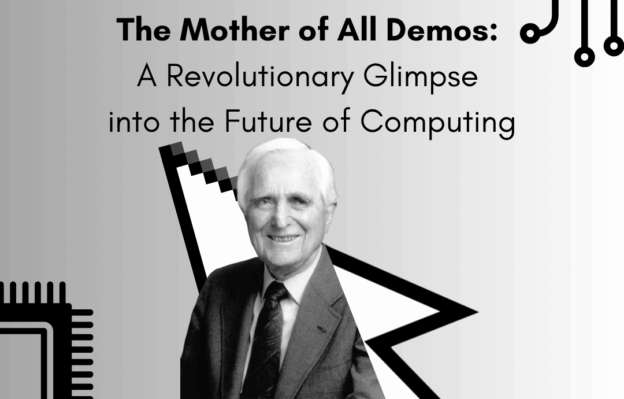On December 9, 1968, Douglas Engelbart’s “The Mother of All Demos” showcased pioneering technologies like the computer mouse, graphical user interface, hypertext, collaborative editing, video conferencing, and advanced word processing, which became foundational to modern computing. While he did not anticipate the internet’s full scope, mobile computing, AI, cloud services, social media, or quantum computing, his visionary work laid the groundwork for the digital revolution, demonstrating the transformative power of innovative thinking. Engelbart’s legacy continues to inspire advancements in technology.
Introduction
On December 9, 1968, at the Fall Joint Computer Conference in San Francisco, Douglas Engelbart delivered what is now famously known as “The Mother of All Demos.” This presentation marked a pivotal moment in the history of computing, showcasing a plethora of innovations that would eventually become foundational to modern computer technology. Engelbart’s 90-minute demonstration introduced the world to a series of groundbreaking technologies, many of which were decades ahead of their time. Let’s delve into the technological advancements predicted by Engelbart and examine those that were not foreseen in his visionary presentation.
The Mother of All Demos
Technological Advancements Predicted
- The Mouse: Perhaps the most iconic invention demonstrated by Engelbart was the computer mouse. This small, handheld device transformed human-computer interaction, allowing users to point, click, and navigate digital interfaces with unprecedented ease. Today, the mouse is a ubiquitous tool in both personal and professional computing environments.
- Graphical User Interface (GUI): Engelbart’s demo included early iterations of the graphical user interface, featuring windows, icons, and text that could be manipulated with the mouse. This concept would later be refined and popularized by companies like Xerox, Apple, and Microsoft, becoming a standard in personal computing.
- Hypertext: Engelbart showcased the concept of hypertext, which allows users to click on links within a document to navigate to related content. This idea laid the groundwork for the World Wide Web, where hyperlinks connect a vast network of information across the internet.
- Collaborative Real-Time Editing: During the demo, Engelbart and his team demonstrated real-time collaborative editing, where multiple users could work on the same document simultaneously. This feature is now a cornerstone of modern productivity tools like Google Docs and Microsoft Office 365.
- Video Conferencing: Engelbart’s presentation also included a live video conferencing system, highlighting the potential for remote communication and collaboration. Today, video conferencing is an essential tool in both personal and professional settings, with platforms like Zoom, Microsoft Teams, and Skype enabling global connectivity.
- Word Processing and Document Editing: Engelbart demonstrated advanced word processing capabilities, including dynamic editing, search functions, and text manipulation. These features are now standard in modern word processors like Microsoft Word and Google Docs.
Technological Advancements Not Foreseen
- Internet and the World Wide Web: While Engelbart’s demo included hypertext, it did not predict the full scope and impact of the internet and the World Wide Web as we know them today. The global connectivity, vast information networks, and social media platforms that define the internet age were not part of his vision.
- Mobile Computing: Engelbart’s demonstration was firmly rooted in the context of desktop computing. The rise of mobile computing, with smartphones and tablets becoming integral parts of daily life, was not anticipated in his presentation.
- Artificial Intelligence and Machine Learning: The advancements in artificial intelligence and machine learning, which now power everything from personal assistants like Siri and Alexa to complex data analysis and autonomous systems, were not covered in Engelbart’s demo.
- Cloud Computing: The concept of cloud computing, where data and applications are stored and accessed over the internet rather than on local hardware, was not envisioned. Cloud services have revolutionized how we store, share, and process information.
- Social Media: The impact of social media platforms, which have transformed communication, information sharing, and social interactions on a global scale, was not predicted by Engelbart’s demonstration.
- Quantum Computing: The nascent field of quantum computing, which promises to revolutionize processing power and problem-solving capabilities, was not within the scope of Engelbart’s presentation.
Conclusion
Douglas Engelbart’s “The Mother of All Demos” remains a landmark event in the history of computing, showcasing innovations that would shape the future of technology. While many of Engelbart’s predictions have become integral to modern computing, there were several significant advancements that he did not foresee. Nonetheless, his vision and pioneering work laid the foundation for the digital revolution, demonstrating the power of innovative thinking and its potential to transform the world. Engelbart’s legacy continues to inspire technologists and visionaries as we navigate the ever-evolving landscape of computing technology.
